
STUMPED BY STORAGE? HOW TO MAKE THE MOST OF YOUR CSA THIS YEAR!
03/16/18 — Heydon Hatcher
Joining the CSA can be an immensely rewarding experience. It gets folks in touch with the seasons, their region, and directly contributes to the wellbeing of the local community. Despite all the wonderful pros, it can be quite a daunting task to take on unfamiliar fruits and veggies when you unveil your weekly haul. It forces you to try new cooking techniques, attempt new recipes, and get to know the seasonality and personalities of so many veggies. On top of that, storage of these veggies can be a giant challenge on its own. Do I keep the tomatoes in the fridge? Do the collards need to be covered? How long do certain things stay fresh? Smart storage is an integral skill in order to ensure the longevity of our farm-fresh veggies for all those adventurous recipes you have planned for the week.
![]() Ada readying her herbs for the fridge. Photo by Scott David Gordon.
Ada readying her herbs for the fridge. Photo by Scott David Gordon.
Some veggies prefer room temperature, while others prefer dark, cool cabinets. Some are sensitive to light and ethylene (a maturing agent that some veggies emit), while others need to have their stems emerged in water in the fridge. In the list below, we dive into all the nuances of veggie care. Take a peek!![]() Bag options. Photo by Scott David Gordon.
Bag options. Photo by Scott David Gordon.
![]() Ada's frozen goods to prolong seasons and circumvent waste. Photo by Scott David Gordon.
Ada's frozen goods to prolong seasons and circumvent waste. Photo by Scott David Gordon.
![]() Ada's compost pile. Photo by Scott David Gordon.
Ada's compost pile. Photo by Scott David Gordon.
Broccoli + Cauliflower - Get these yummy crops into a baggy or container in the refrigerator’s crisper drawer, and they should be good for a week.
Bulk Roots (rutabagas, radishes, turnips, beets without greens attached) - If greens are attached, remove and then store in the refrigerator in a bag or container of some sort to keep the moisture in. Beets can last up to 3 weeks, radishes can last up to 2 weeks, and lastly, turnips and rutabagas can last up to 2 weeks. The greens of beets and turnips should be enjoyed within 3 days of being trimmed, and stored in a container or bag after being cleaned and dried.
Carrots - Cut off the greens if they come bunched (Make pesto with the greens!) and put in a container or bag in the crisper drawer, and these tasty snack veggies will last about 2 to 3 weeks.
![]() Carrots and beets getting greens chopped off. Photo by Scott David Gordon.
Carrots and beets getting greens chopped off. Photo by Scott David Gordon.
Cucumbers - This summertime sweetheart should be stored at room temperature, if it is stored anywhere below 50 degrees, it sustains “chilling injuries,” like pitting and accelerated decay. Keep them away from tomatoes, melons, and bananas, which emit ethylene (a maturing agent) since cucumbers are highly sensitive to it.
Eggplant - Similar to the cucumber, this nightshade stores well on the countertop. If your kitchen runs hotter than typical room temperature, it would be beneficial to store this veggie in a dark cupboard. It should keep for 2 to 5 days. Be sure to keep away from high ethylene producing vegetables! Eggplants are sensitive like the aforementioned cucumbers to this chemical.
Cabbage - This should be stored in a bag or container, in the crisper drawer. In these conditions, these crispy greens will last about 2 weeks.
Potatoes - Put these in a paper bag in a dark pantry, and they can last a month! Be sure air can circulate around them.
![]() Potatoes in a sack. Photo by Scott David Gordon.
Potatoes in a sack. Photo by Scott David Gordon.
Salad Greens (arugula, spinach, romaine, loose-leaf lettuce) - If these come in a little dirty, don't be alarmed. For easiest meal prep, you can wash these when you get them; however, make sure that they're completely dried before you put them in the fridge! Any water left on these leafy greens will turn them into slime. There are two great ways to ensure dryness. First off, a salad spinner - for the fall and winter seasons, this kitchen tool is well worth it and a huge time-saver. You can always use the bowl for other functions, too! If a salad spinner isn’t your speed, another good way to dry greens is by laying them out on a tea towel and wrapping them in the towel until they are good and dry. For especially muddy greens (sometimes our low-growing spinach comes in pretty muddy), you can dunk these in a bowl of water. Pro ecological tip: reuse water to water a houseplant! These should remain fresh for about 10 days.
![]() Salad spinner. Photo by Scott David Gordon.
Salad spinner. Photo by Scott David Gordon.
![]() Drying out greens via tea towel. Photo by Scott David Gordon.
Drying out greens via tea towel. Photo by Scott David Gordon.
Side note: if your greens show up looking wilted, refresh them and bring them back to life! This is easily done by soaking them in water, storing them in the fridge with a bag over them or lightly covered with plastic. Store them in the fridge like this until they look better. Then take them out, let the bottoms dry out, and store in a bag or container.
Kohlrabi - Cut the leaves off the bulb (you can eat the greens! Clean and use within three days), scrub the bulb, and place in a container or bag in the crisper drawer. These should keep for about a week.
Leeks - Trim the dark ends, and keep the roots intact. Place in a container or bag, get them in the refrigerator, and they should last about a week.
Melons - To ripen melons, keep in a paper bag on your kitchen counter. Once it starts to smell slightly sweet and give around the stem when pressed, put into the fridge. Once they are ripe, eat these fruits ASAP! You can keep them in the fridge for up to 5 days. Once cut, keep exposed flesh covered in plastic. Cut melons should keep for up to 3 days.
Watermelon - Keep these summertime darlings in the fridge. This melon, once off the vine, will ripen no further. Storing these melons in the cold also make them that much more refreshing once you cut them open. Uncut, watermelons stay fresh for 2 to 3 weeks. Once cut, cover the exposed fleshy side in plastic and keep in the fridge. It will remain fresh for up to three days.
Herbs (parsley, cilantro) - Treat these like bunched greens. If they need refreshing, you can trim the stems and place in a cup of water. Once sufficiently refreshed, store these in a lightly sealed bag in the crisper drawer. They should store for about a week.
![]() Herbs getting a good soak. Photo by Scott David Gordon.
Herbs getting a good soak. Photo by Scott David Gordon.
Okra - Store in a bag or container or wrap in a paper towel and place in a perforated bag, then place the fresh okra in the fridge (make sure that the okra is dry after washing before storing them in the fridge, can lead to slimy mold if not dry). This veggie should last about 3 days in these conditions.
Onions - Place in a dark pantry, and these hardy bulbs should last about 1 to 2 months! Make sure that air can circulate around them. If you cut into one of these, you should store in the fridge and use the rest within 3 to 4 days for maximum freshness.
Peppers - Get into a container or bag of some sort and into the fridge, and they should last about 5 days!
Bunched Greens (chard, beet greens, kale, collards, mustard greens) - These greens need to be trimmed at the bottom, washed, dried thoroughly before being bagged and/or placed in a container and into the crisper drawer. They should remain fresh for about a week.
![]() Chopping chard. Photo by Scott David Gordon.
Chopping chard. Photo by Scott David Gordon.
![]() Kale bath. Photo by Scott David Gordon.
Kale bath. Photo by Scott David Gordon.
Side note: If your bunched greens are looking sad when you get them, you can easily refresh them! Follow tips listed in "Salad Greens" for the 411 on that procedure.
Summer Squash - Place in a plastic bag or closed container like a tupperware and keep in the fridge. This summertime crop will last about 5 days in these conditions.
Sweet Potatoes - In a paper bag in a dark pantry, these 'taters will last about 2 weeks.
Tomatoes - These divas prefer storage on the countertop. If you have a well-vented container, tomatoes love to live in those. For quicker ripening, put in a paper bag so ethylene can build up (this is the chemical that causes ripening and acts as a maturing agent). These will store for 3-5 days.
Winter Squash (butternut, acorn) - These gourds love to be unwrapped in a dark, cool pantry. In these conditions, they will store for about a month.
![]() Veggies ready for the week in the crisper drawer. Photo by Scott David Gordon.
Veggies ready for the week in the crisper drawer. Photo by Scott David Gordon.
We hope this helps in your weekly CSA adventures! 'Til next time.
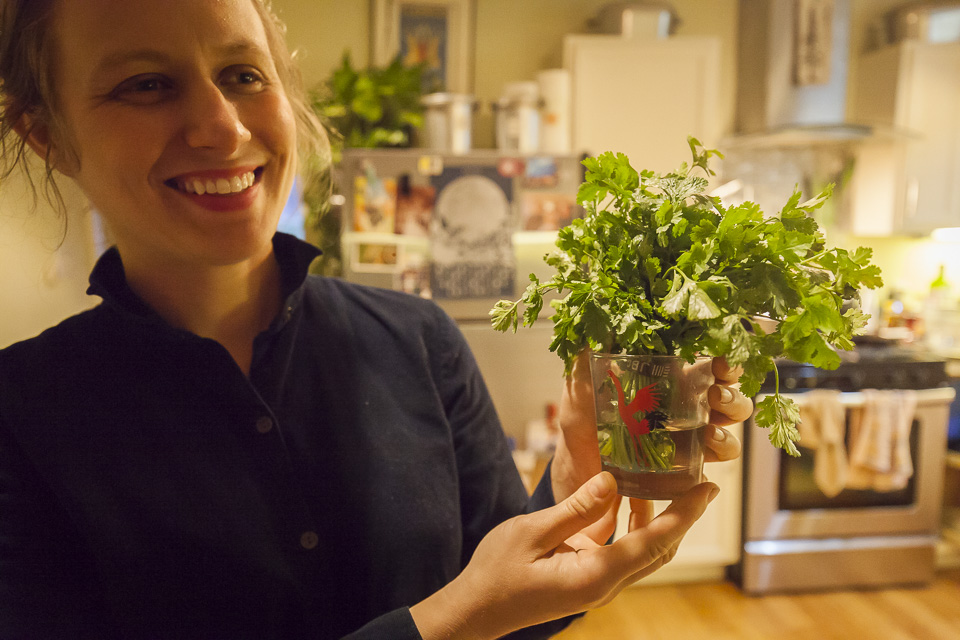 Ada readying her herbs for the fridge. Photo by Scott David Gordon.
Ada readying her herbs for the fridge. Photo by Scott David Gordon.
Some veggies prefer room temperature, while others prefer dark, cool cabinets. Some are sensitive to light and ethylene (a maturing agent that some veggies emit), while others need to have their stems emerged in water in the fridge. In the list below, we dive into all the nuances of veggie care. Take a peek!
Quick Pointers to Ponder
- When storing produce, any time that plants are left uncovered, they are going to lose moisture, and wilt. Putting them in a bag is a great way to retain humidity, and this pertains to a lot of different crops. It's important to separate the greens from the roots as the greens will continue to extract water from roots. Think: carrots/beets - the roots will stay firmer once the greens have been removed.
- One vital aspect of storage is temperature. Vegetables prefer different temperatures to grow in, and the same goes for storage. In the below list we mention: the refrigerator, the crisper drawer, dark cabinets, and the countertop. Refrigerators are obviously great options for storage, with the fridge crisper drawers being even better options with specific settings that control humidity levels, etc.
- In the list below, we mention “place them into a bag or a container” quite often. This deserves a little more elaboration, a container can mean a sealable glass or plastic tupperware, and a bag can mean a plastic bag, recycled produce bags from the grocery store, ziplocks, or even fancy mesh produce bags (shown in the picture below). *** Though the plastic bags might seem wasteful, please note that you can reuse them until they fall apart and the zippers break. New kale goes into the old kale bag… if you use a paper towel to wrap veggies, you can reuse it to wipe up a spill, so on and so forth.
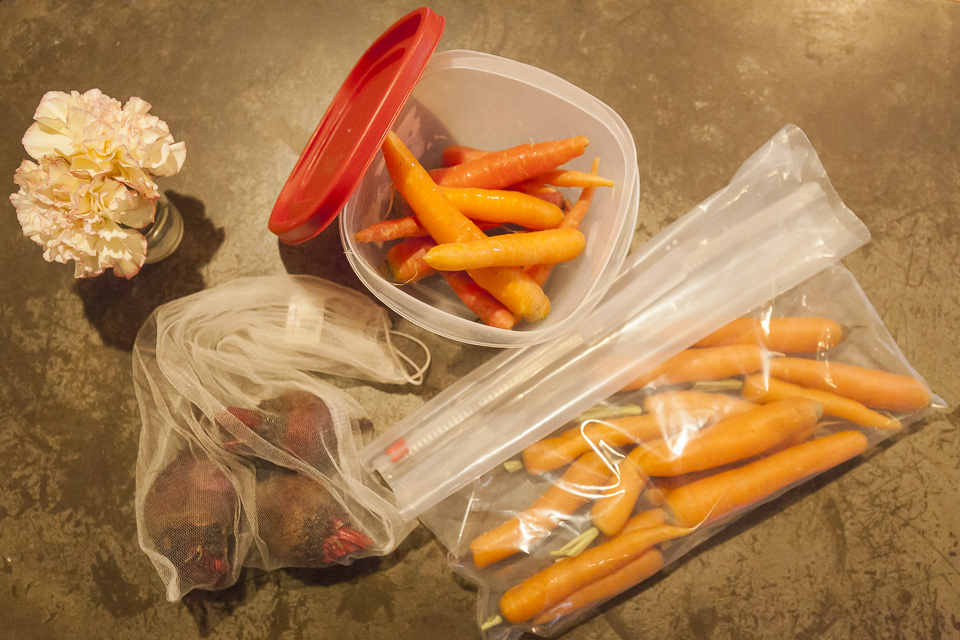 Bag options. Photo by Scott David Gordon.
Bag options. Photo by Scott David Gordon.
- Another pro-tip is to have long-term storage on the mind, and freeze produce! Too many beets and tomatoes? Longer term storage is a good way to extend the season. Blanching veggies and freezing them works well for a lot of different vegetables. For a bit more involved approach, you can also preserve and can! Quick pickling is also a great way to use excess veggies and is definitely easier than it sounds.
 Ada's frozen goods to prolong seasons and circumvent waste. Photo by Scott David Gordon.
Ada's frozen goods to prolong seasons and circumvent waste. Photo by Scott David Gordon.
- By adventuring outside the plate with new recipes, you can expand your palate, and also learn new delicious, staple recipes for years to come. Need a good resource for veggie-specific recipes? Check out our Pinterest board here!
- With just a little weekly prep, you can really change the way you cook during the week. Wash and cut your greens when you get your box, and you are more likely to use them in the week ahead.
- Feel like you are wasting tons of veggies week after week? One way to skip out on wasting veggies is to trade out those veggies you aren’t so keen on with ones you know you will use when you pick up your CSA at the market, or by using our customization feature online! If all else fails and you don’t get around to using all your veggies, COMPOST! Then, you’ll really know that your veggie waste is going to good use.
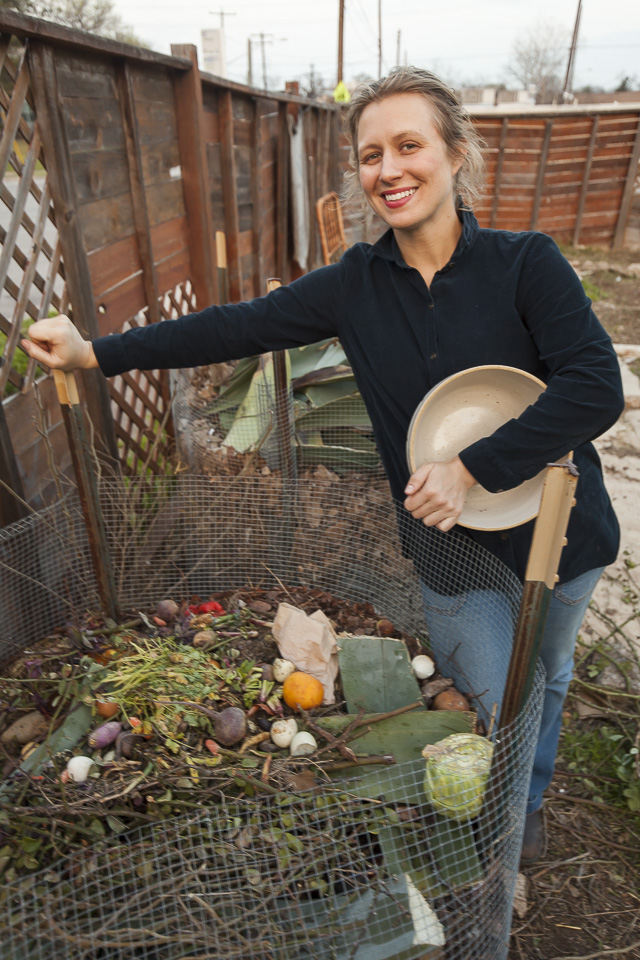 Ada's compost pile. Photo by Scott David Gordon.
Ada's compost pile. Photo by Scott David Gordon.
Storage Tips by Veggie
Basil - Tender and leafy herb. Place bunch in a cup of water and lightly cover entire bunch with a plastic bag. When you get your bunch, trim the bottom of the stems for best results. These do best on a countertop. Usually lasts around 5-7 days.Broccoli + Cauliflower - Get these yummy crops into a baggy or container in the refrigerator’s crisper drawer, and they should be good for a week.
Bulk Roots (rutabagas, radishes, turnips, beets without greens attached) - If greens are attached, remove and then store in the refrigerator in a bag or container of some sort to keep the moisture in. Beets can last up to 3 weeks, radishes can last up to 2 weeks, and lastly, turnips and rutabagas can last up to 2 weeks. The greens of beets and turnips should be enjoyed within 3 days of being trimmed, and stored in a container or bag after being cleaned and dried.
Carrots - Cut off the greens if they come bunched (Make pesto with the greens!) and put in a container or bag in the crisper drawer, and these tasty snack veggies will last about 2 to 3 weeks.
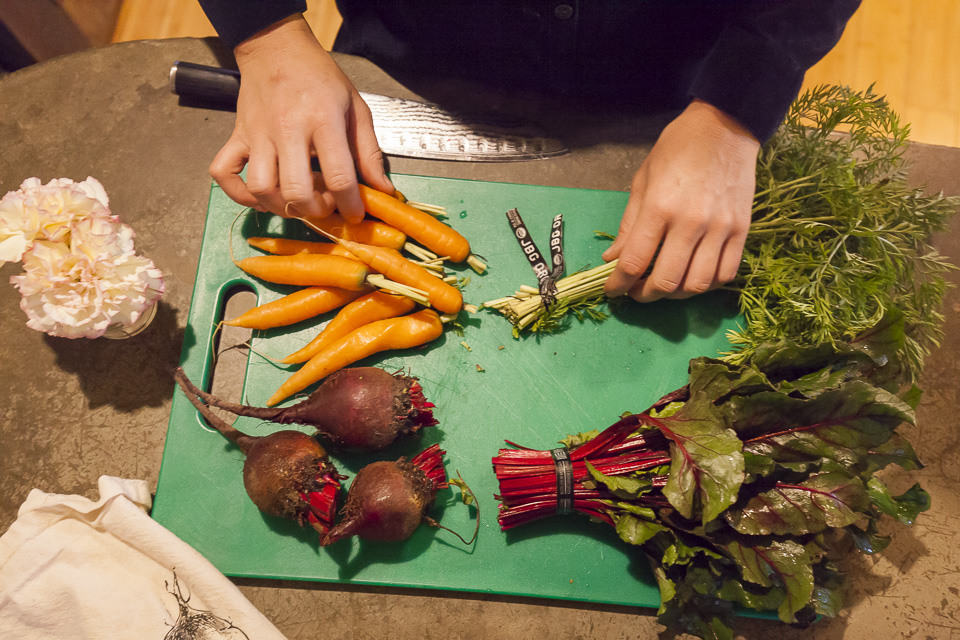 Carrots and beets getting greens chopped off. Photo by Scott David Gordon.
Carrots and beets getting greens chopped off. Photo by Scott David Gordon.
Cucumbers - This summertime sweetheart should be stored at room temperature, if it is stored anywhere below 50 degrees, it sustains “chilling injuries,” like pitting and accelerated decay. Keep them away from tomatoes, melons, and bananas, which emit ethylene (a maturing agent) since cucumbers are highly sensitive to it.
Eggplant - Similar to the cucumber, this nightshade stores well on the countertop. If your kitchen runs hotter than typical room temperature, it would be beneficial to store this veggie in a dark cupboard. It should keep for 2 to 5 days. Be sure to keep away from high ethylene producing vegetables! Eggplants are sensitive like the aforementioned cucumbers to this chemical.
Cabbage - This should be stored in a bag or container, in the crisper drawer. In these conditions, these crispy greens will last about 2 weeks.
Potatoes - Put these in a paper bag in a dark pantry, and they can last a month! Be sure air can circulate around them.
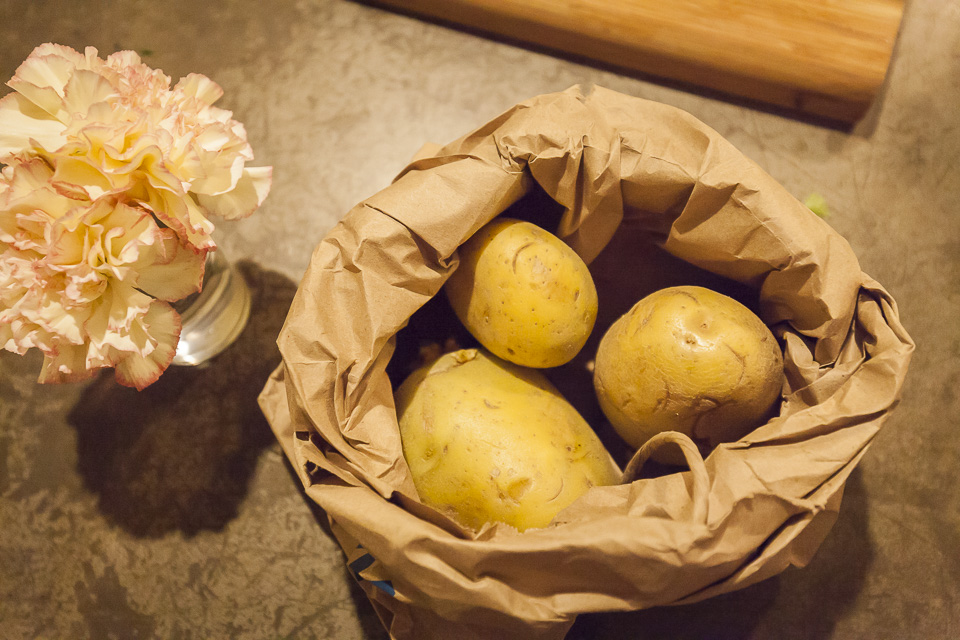 Potatoes in a sack. Photo by Scott David Gordon.
Potatoes in a sack. Photo by Scott David Gordon.
Salad Greens (arugula, spinach, romaine, loose-leaf lettuce) - If these come in a little dirty, don't be alarmed. For easiest meal prep, you can wash these when you get them; however, make sure that they're completely dried before you put them in the fridge! Any water left on these leafy greens will turn them into slime. There are two great ways to ensure dryness. First off, a salad spinner - for the fall and winter seasons, this kitchen tool is well worth it and a huge time-saver. You can always use the bowl for other functions, too! If a salad spinner isn’t your speed, another good way to dry greens is by laying them out on a tea towel and wrapping them in the towel until they are good and dry. For especially muddy greens (sometimes our low-growing spinach comes in pretty muddy), you can dunk these in a bowl of water. Pro ecological tip: reuse water to water a houseplant! These should remain fresh for about 10 days.
 Salad spinner. Photo by Scott David Gordon.
Salad spinner. Photo by Scott David Gordon.
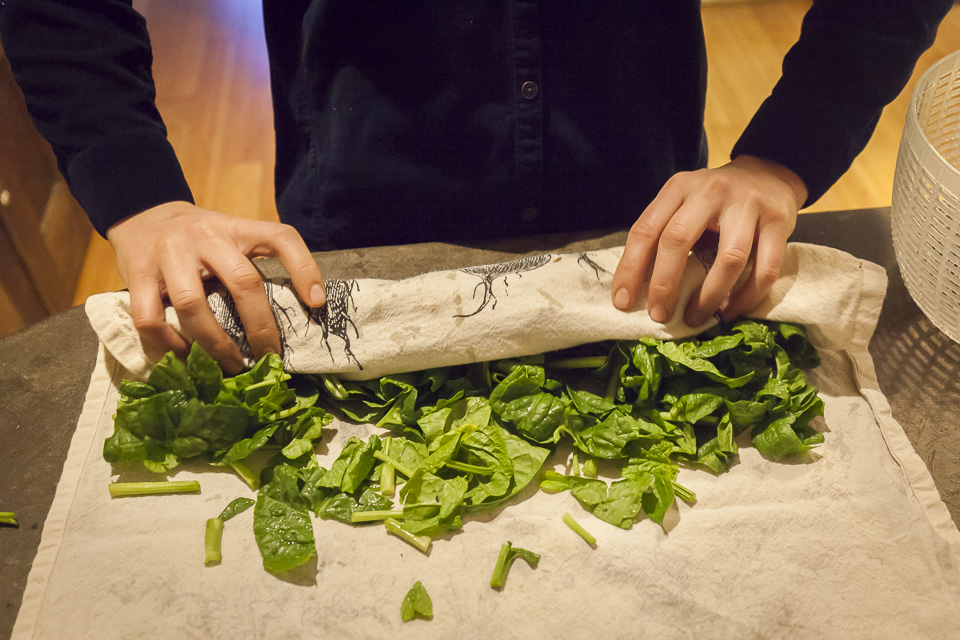 Drying out greens via tea towel. Photo by Scott David Gordon.
Drying out greens via tea towel. Photo by Scott David Gordon.
Side note: if your greens show up looking wilted, refresh them and bring them back to life! This is easily done by soaking them in water, storing them in the fridge with a bag over them or lightly covered with plastic. Store them in the fridge like this until they look better. Then take them out, let the bottoms dry out, and store in a bag or container.
Kohlrabi - Cut the leaves off the bulb (you can eat the greens! Clean and use within three days), scrub the bulb, and place in a container or bag in the crisper drawer. These should keep for about a week.
Leeks - Trim the dark ends, and keep the roots intact. Place in a container or bag, get them in the refrigerator, and they should last about a week.
Melons - To ripen melons, keep in a paper bag on your kitchen counter. Once it starts to smell slightly sweet and give around the stem when pressed, put into the fridge. Once they are ripe, eat these fruits ASAP! You can keep them in the fridge for up to 5 days. Once cut, keep exposed flesh covered in plastic. Cut melons should keep for up to 3 days.
Watermelon - Keep these summertime darlings in the fridge. This melon, once off the vine, will ripen no further. Storing these melons in the cold also make them that much more refreshing once you cut them open. Uncut, watermelons stay fresh for 2 to 3 weeks. Once cut, cover the exposed fleshy side in plastic and keep in the fridge. It will remain fresh for up to three days.
Herbs (parsley, cilantro) - Treat these like bunched greens. If they need refreshing, you can trim the stems and place in a cup of water. Once sufficiently refreshed, store these in a lightly sealed bag in the crisper drawer. They should store for about a week.
 Herbs getting a good soak. Photo by Scott David Gordon.
Herbs getting a good soak. Photo by Scott David Gordon.
Okra - Store in a bag or container or wrap in a paper towel and place in a perforated bag, then place the fresh okra in the fridge (make sure that the okra is dry after washing before storing them in the fridge, can lead to slimy mold if not dry). This veggie should last about 3 days in these conditions.
Onions - Place in a dark pantry, and these hardy bulbs should last about 1 to 2 months! Make sure that air can circulate around them. If you cut into one of these, you should store in the fridge and use the rest within 3 to 4 days for maximum freshness.
Peppers - Get into a container or bag of some sort and into the fridge, and they should last about 5 days!
Bunched Greens (chard, beet greens, kale, collards, mustard greens) - These greens need to be trimmed at the bottom, washed, dried thoroughly before being bagged and/or placed in a container and into the crisper drawer. They should remain fresh for about a week.
 Chopping chard. Photo by Scott David Gordon.
Chopping chard. Photo by Scott David Gordon.
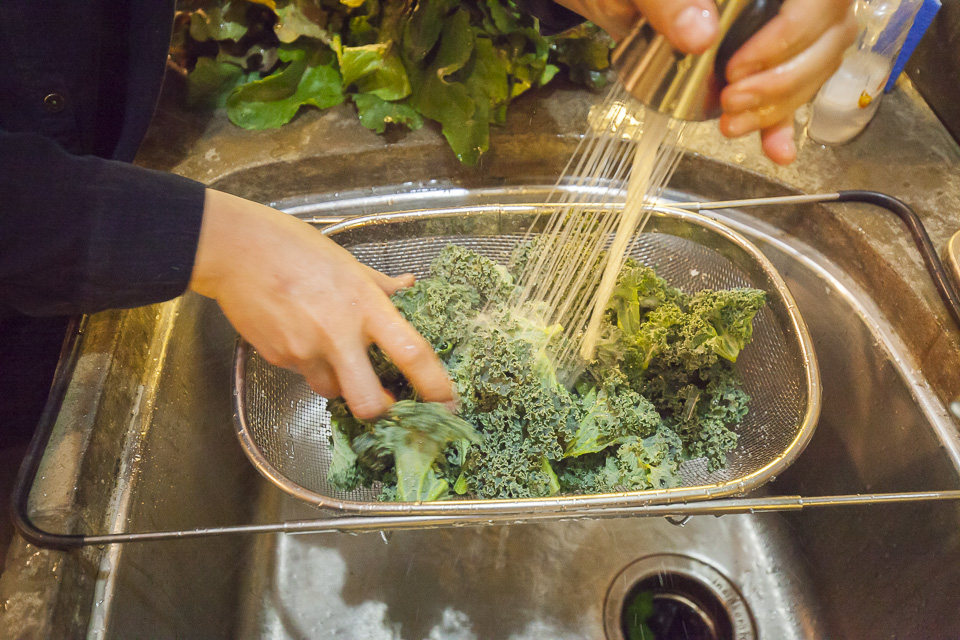 Kale bath. Photo by Scott David Gordon.
Kale bath. Photo by Scott David Gordon.
Side note: If your bunched greens are looking sad when you get them, you can easily refresh them! Follow tips listed in "Salad Greens" for the 411 on that procedure.
Summer Squash - Place in a plastic bag or closed container like a tupperware and keep in the fridge. This summertime crop will last about 5 days in these conditions.
Sweet Potatoes - In a paper bag in a dark pantry, these 'taters will last about 2 weeks.
Tomatoes - These divas prefer storage on the countertop. If you have a well-vented container, tomatoes love to live in those. For quicker ripening, put in a paper bag so ethylene can build up (this is the chemical that causes ripening and acts as a maturing agent). These will store for 3-5 days.
Winter Squash (butternut, acorn) - These gourds love to be unwrapped in a dark, cool pantry. In these conditions, they will store for about a month.
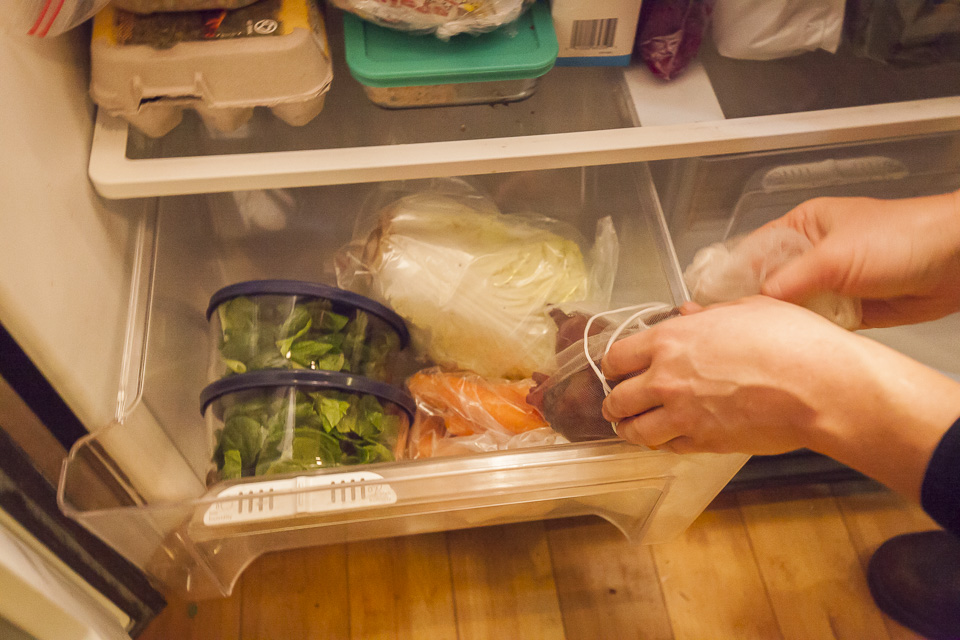 Veggies ready for the week in the crisper drawer. Photo by Scott David Gordon.
Veggies ready for the week in the crisper drawer. Photo by Scott David Gordon.
We hope this helps in your weekly CSA adventures! 'Til next time.






 0 ITEMS IN CART
0 ITEMS IN CART 

